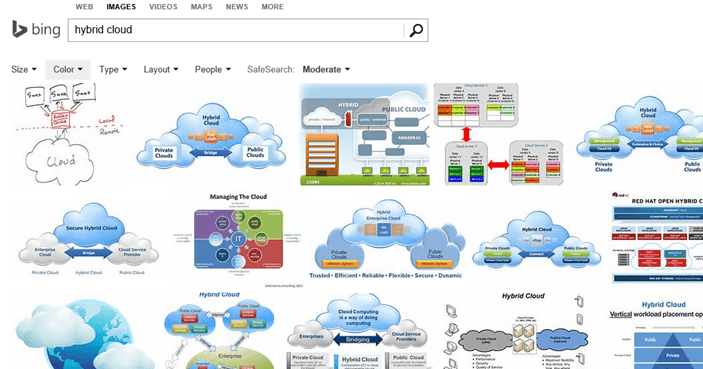 A Bing search for the term "hybrid cloud."[/caption] So what does the word “hybrid” mean in a literal sense? Reference.com defines it as, "Anything derived from heterogeneous sources, or composed of elements of different or incongruous kinds." Hybrid is the combination of two different "ideas," or in SharePoint's case, the combination of two different types of client/server architectures. It represents the unification of technologies, trends, and – more importantly – splits between the on-premises and cloud models. The lines between these two models have been drawn over the last few years and now the hybrid concept sits between the two and satisfies the needs of many customers. There has been a push over the last couple of years toward cloud computing with distributed computing models. The reasoning behind the shift is to increase computing efficiency and reduce costs. Think of it as a rush to move everyone in the city into apartments. These apartments may be different sizes and have different layouts, but they are still within a shared living space and access many of the same resources. On premises or locally hosted architecture, on the other hand, could be compared to single family homes. Everyone has their own space, though this model is not necessarily as efficient. The Hybrid approach could be compared to town or row houses, where valuable resources are shared when they can be but the units have higher occupancy overall. These same comparisons also apply to flexibility within each scenario. Apartment dwellers may not be able to change the layout of the hallways in their building or reroute the plumbing easily. This logic also applies to network resources or machine sizes when it comes to cloud deployments – outside of the standard offerings of the cloud service. Conversely, the single family home owner is free to modify the dwelling as desired. However, the responsibility of managing, upgrading, and improving all aspects of the home lies solely with them. On-premises deployments offer the most flexibility for organizations, but that can often require more maintenance and expenses, especially as data inevitably grows. Finally, townhome owners may not be able to change their roofs without approval or coordination, but they have the capability to change the interior of the dwelling to a point. Hybrid's approach is to claim the best of both worlds: the flexibility of on-premises environments with the availability and scalability of cloud resources. In the end, it all comes down to finding the right housing for your business data. How flexible does your data need to be? How available? How secure? All of these questions will help determine within which neighborhood your data belongs. And remember that often the objections to moving to the cloud are the counterpoints in favor of the cloud. [caption id="attachment_1735" align="alignnone" width="685"]
A Bing search for the term "hybrid cloud."[/caption] So what does the word “hybrid” mean in a literal sense? Reference.com defines it as, "Anything derived from heterogeneous sources, or composed of elements of different or incongruous kinds." Hybrid is the combination of two different "ideas," or in SharePoint's case, the combination of two different types of client/server architectures. It represents the unification of technologies, trends, and – more importantly – splits between the on-premises and cloud models. The lines between these two models have been drawn over the last few years and now the hybrid concept sits between the two and satisfies the needs of many customers. There has been a push over the last couple of years toward cloud computing with distributed computing models. The reasoning behind the shift is to increase computing efficiency and reduce costs. Think of it as a rush to move everyone in the city into apartments. These apartments may be different sizes and have different layouts, but they are still within a shared living space and access many of the same resources. On premises or locally hosted architecture, on the other hand, could be compared to single family homes. Everyone has their own space, though this model is not necessarily as efficient. The Hybrid approach could be compared to town or row houses, where valuable resources are shared when they can be but the units have higher occupancy overall. These same comparisons also apply to flexibility within each scenario. Apartment dwellers may not be able to change the layout of the hallways in their building or reroute the plumbing easily. This logic also applies to network resources or machine sizes when it comes to cloud deployments – outside of the standard offerings of the cloud service. Conversely, the single family home owner is free to modify the dwelling as desired. However, the responsibility of managing, upgrading, and improving all aspects of the home lies solely with them. On-premises deployments offer the most flexibility for organizations, but that can often require more maintenance and expenses, especially as data inevitably grows. Finally, townhome owners may not be able to change their roofs without approval or coordination, but they have the capability to change the interior of the dwelling to a point. Hybrid's approach is to claim the best of both worlds: the flexibility of on-premises environments with the availability and scalability of cloud resources. In the end, it all comes down to finding the right housing for your business data. How flexible does your data need to be? How available? How secure? All of these questions will help determine within which neighborhood your data belongs. And remember that often the objections to moving to the cloud are the counterpoints in favor of the cloud. [caption id="attachment_1735" align="alignnone" width="685"] Arguments for on-premises, cloud, and hybrid scenarios.[/caption] [Image 1 Source] [Image 2 Source] [Image 3 Source] What this means is that a better analysis of what data exists and where that data should live must occur before deciding which approach is best for you. This analysis should occur before the technology shift or the decision to stay legacy happens. Then it becomes a choice of which tool is best for your data. To learn more about AvePoint’s offerings around hybrid SharePoint deployments, visit our Cloud Solutions page. What are your thoughts on hybrid scenarios for SharePoint environments? Be sure to weigh in by leaving a comment below.
Arguments for on-premises, cloud, and hybrid scenarios.[/caption] [Image 1 Source] [Image 2 Source] [Image 3 Source] What this means is that a better analysis of what data exists and where that data should live must occur before deciding which approach is best for you. This analysis should occur before the technology shift or the decision to stay legacy happens. Then it becomes a choice of which tool is best for your data. To learn more about AvePoint’s offerings around hybrid SharePoint deployments, visit our Cloud Solutions page. What are your thoughts on hybrid scenarios for SharePoint environments? Be sure to weigh in by leaving a comment below.
